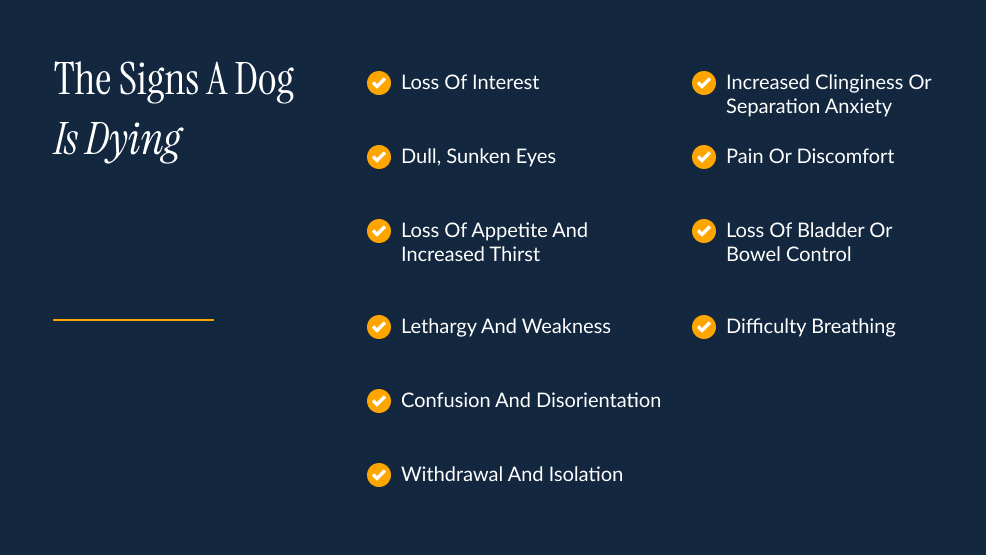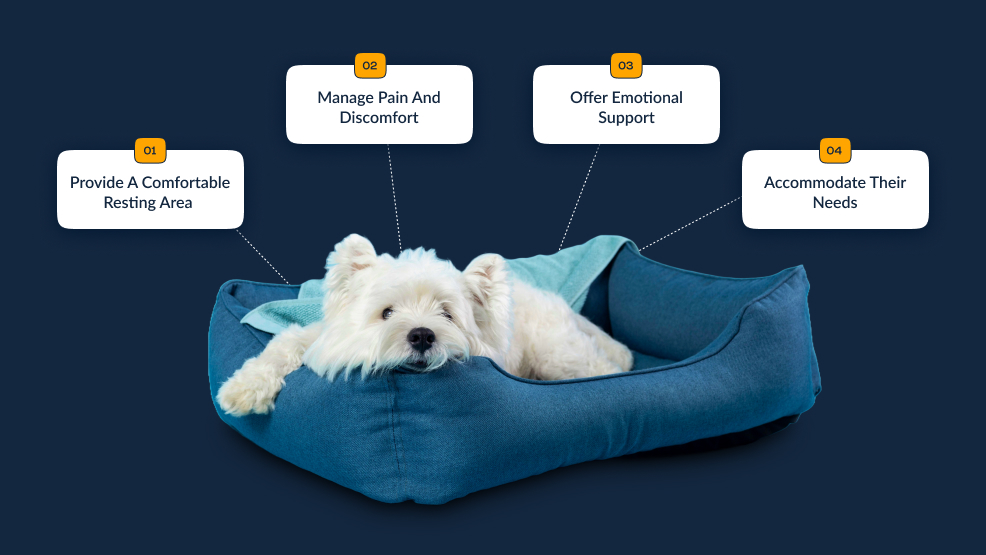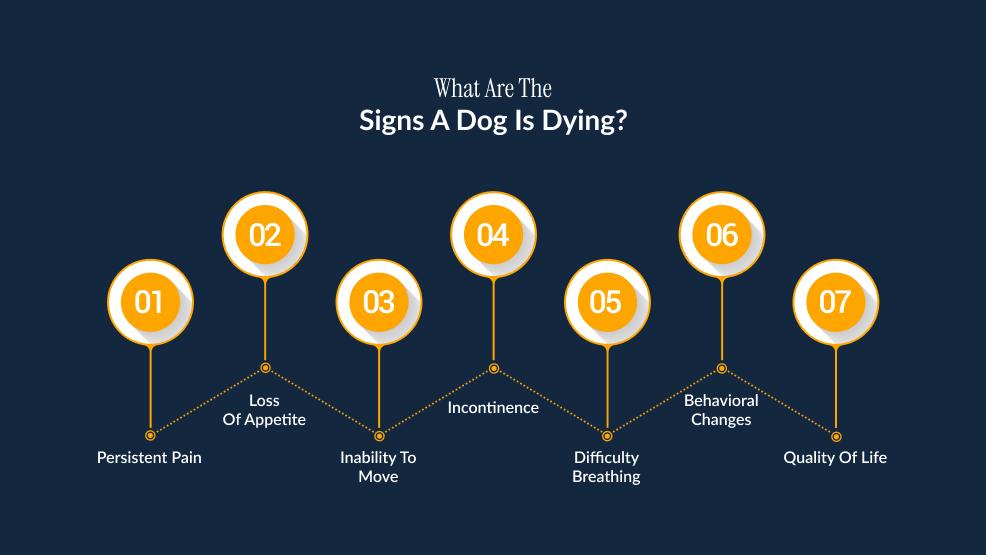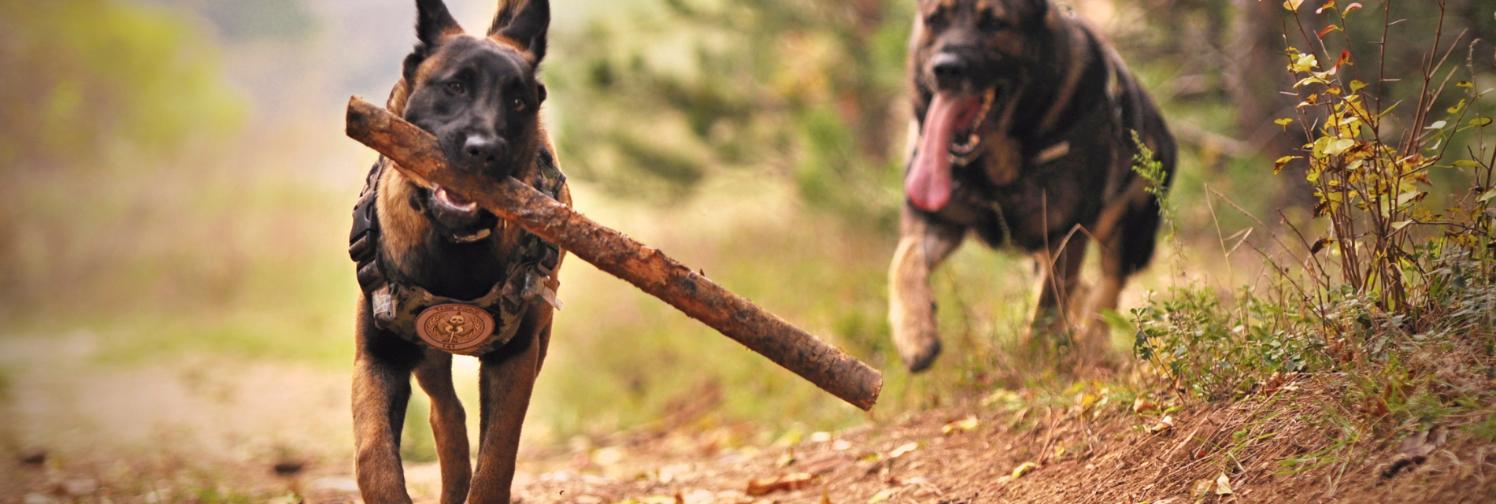What Are The Signs A Dog Is Dying: Is it time to say goodbye?


Seeing our furry family members get older and slower over the years is already a very difficult thing to witness. However, saying goodbye to them is one of the most heart-wrenching experiences that nobody looks forward to. After all, they are not just pets; they are family members. They bring so much joy and love into our lives that losing them is incredibly tough for any pet parent.
However, as they get older or if they are suffering from any serious terminal illness for a long time, it is important to know what the signs are a dog is dying. It is not easy in any way. But knowing and understanding the signs that your dog might be nearing the end of its life can help you to provide your senior dog with the best possible supportive care. You can make their final days as comfortable as you can.
It will also help you to prepare yourself emotionally for this difficult time. So, let’s explore what are the signs a dog is dying. As a pet parent, I know it can be quite a difficult topic for some, so be prepared.
What Are The Signs A Dog Is Dying?

It’s heartbreaking to think that our best friend is nearing the end of their life, but knowing the signs can help you provide them with the best care and comfort possible. At the same time, you must remember that these signs do not necessarily mean they will pass away soon. It just means that your dog’s health is declining. These are as follows:
Loss of Interest
You may see your elder dog slowly lose interest in their favorite activities like playtime and social interactions, toys, treats, and even greeting you when you return home. This can be due to various factors like fatigue, pain, or a general decline in their physical and mental health. It is often one of the first signs your dog is dying of old age.
Dull, Sunken Eyes
You will see that as your pup ages, their eyes will slowly lose their usual brightness and appear glassy, cloudy, or dull. This is a normal age-related change and often a sign of overall decline. You may also notice that your dog struggles to focus on objects or people. However, dull or cloudy eyes are also the first indicator of underlying eye issues. Some of these issues are treatable, so take your dog to the vet for a consultation as soon as possible.
Loss of Appetite and Increased Thirst
One of the most common signs your dog with diabetes is dying is a decreased appetite or complete loss of interest in food. This can lead to significant weight loss, which can be concerning, especially if it occurs rapidly. It will also cause dehydration, leading to dog eyes red.
Also, while frequent urination and drinking more water than usual are common signs of diabetes, if you notice an increase in frequency, you should be concerned. This indicates that diabetes is getting out of control.
Lethargy and Weakness
As a dog’s body begins to slow down, you might notice a significant decrease in energy levels. They might spend more time sleeping, have trouble getting up, or seem less interested in their usual activities.
Confusion and disorientation
As your dog’s cognitive abilities decline, they may appear confused or disoriented, even in familiar surroundings. This can be distressing for both you and your furry companion. This is a very common old dog behavior before death.
Withdrawal and isolation
Your dog may start withdrawing from social interactions, preferring to spend more time alone or in a quiet, secluded area. This behavior can signify discomfort or a desire for peace and tranquility.
Increased clinginess or separation anxiety
Some dogs may become more clingy or exhibit signs of separation anxiety as they sense their time with you is limited. They may follow you around more or become distressed when you leave the room.
Pain or discomfort
As your dog’s health deteriorates, they may exhibit signs of pain or discomfort, such as whimpering or restlessness. You may hear them crying at night frequently if they are in a lot of pain. They might also be reluctant to move or touch certain areas of their body. It can be distressing for both you and your senior pup, so consult your vet, who can advise you on the best course of action.
Loss of bladder or bowel control
Your dog may start having accidents inside the house, even if it was previously well-trained. It is an indication that they are slowly losing control over their bodily function due to underlying health issues.
Difficulty breathing
Senior dogs may experience labored breathing, panting, or wheezing, even when they are lying down. This is because as the body’s overall condition deteriorates, breathing normally becomes increasingly challenging. The deterioration is most often caused due to progressive failure of vital organs.
You should also remember that there can be many reasons why your dog is nearing the end of its life. Consequently, what are signs your dog is dying can vary. If you’re concerned about your dog’s health, it’s always best to consult with your vet.
The most important thing is to observe your dog closely, trust your instincts, and don’t hesitate to contact the vet if you think your dog is in too much pain or discomfort.
How to Make Your Dog Feel Comfortable During the End-of-life Stage

As your dog approaches the end of their life, it’s essential to prioritize their comfort and well-being. Here are some tips to help make your furry friend as comfortable as possible during this delicate stage:
Provide a Comfortable Resting Area
Create a cozy and quiet space for your dog to rest, with soft bedding, familiar toys, and easy access to water and food (if they are still eating). This can help them feel secure and at ease.
Manage Pain and Discomfort
Work closely with your veterinarian to ensure your dog’s pain and discomfort are properly managed. This may involve medications, alternative therapies, or other interventions like heated dog bed to alleviate their suffering.
Offer Emotional Support
Spend quality time with your dog, providing gentle petting, soothing words, and reassurance. Your presence and affection can be a great source of comfort during this difficult time.
Accommodate Their Needs
As your dog’s mobility decreases, make accommodations to ensure their basic needs are met. This may involve using puppy pads or diapers for incontinence, providing ramps or assistance for getting around, and ensuring they have easy access to food and water.
You should remember that making your dog comfortable during the end-of-life stage is not just about physical care but also about providing emotional support and creating a peaceful and loving environment for them to transition.
How Can I Tell When It’s the Right Time to Decide to Say Goodbye?

Deciding when to say goodbye to a beloved dog is incredibly difficult, but some signs can help guide you. Here are a few key indicators that it might be time to consider euthanasia:
Persistent Pain
If your dog is in constant pain that cannot be managed with medication, it might be time to consider euthanasia. Signs of pain include whining, whimpering, restlessness, and difficulty moving.
Loss of Appetite
A significant and persistent loss of appetite can indicate that your dog is no longer enjoying life. If they refuse to eat or drink, it can lead to severe weight loss and dehydration.
Inability to Move
If your dog can no longer stand, walk, or move without significant assistance, their quality of life may be severely impacted. This includes difficulty getting up, climbing stairs, or even walking short distances.
Incontinence
Loss of bladder and bowel control can be distressing for both the dog and the owner. If your dog frequently has accidents and seems distressed by it, this could be a sign.
Difficulty Breathing
Labored or irregular breathing is a serious sign. If your dog struggles to breathe, it can indicate severe health issues.
Behavioral Changes
If your dog has become withdrawn, irritable, or shows signs of confusion and disorientation, it might be a sign of suffering.
Quality of Life
Consider your dog’s overall quality of life. Are they having more bad days than good days? Are they still able to enjoy the things they love? There are quality-of-life scales available that can help you assess this more objectively.
It’s important to have an open and honest conversation with your veterinarian. They can provide guidance based on your dog’s specific condition and help you make the best decision for your pet’s well-being.
Recognizing these signs and accepting that our furry family member is nearing the end is an extremely tough thing to do. Nevertheless, knowing about these changes will help you to provide your senior furbaby with the love, support, and care they need during their final days.
Also, do not forget to ask your veterinarian for help. They can guide you through this difficult period and help you to make your senior dog feel as comfortable and peaceful as possible for the last few days.









Leave A Comment